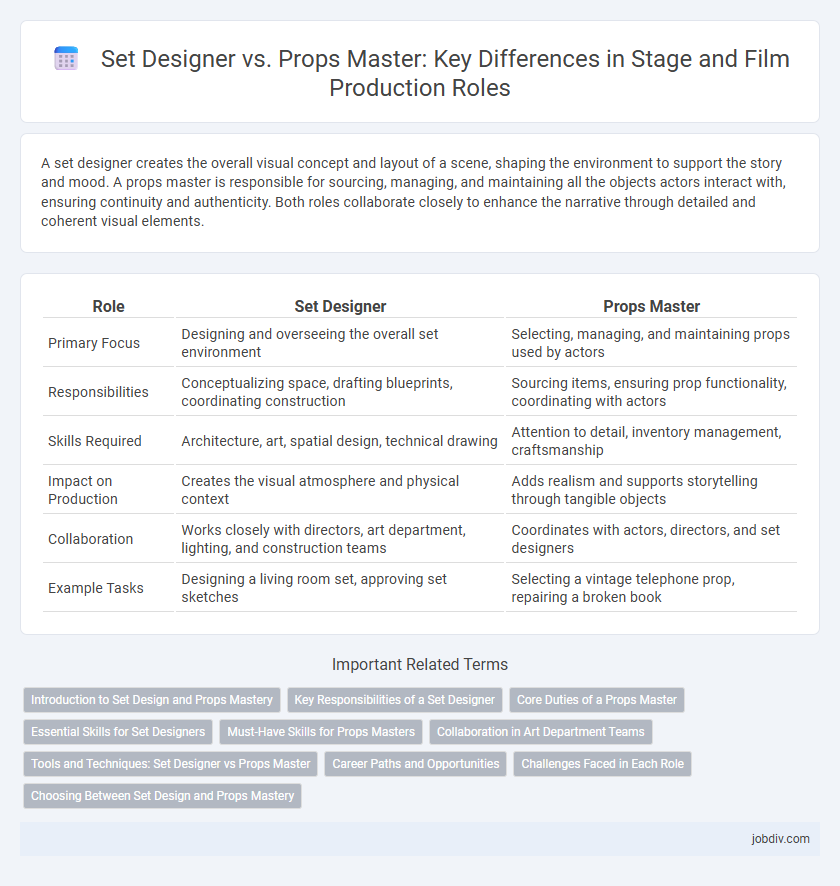A set designer creates the overall visual concept and layout of a scene, shaping the environment to support the story and mood. A props master is responsible for sourcing, managing, and maintaining all the objects actors interact with, ensuring continuity and authenticity. Both roles collaborate closely to enhance the narrative through detailed and coherent visual elements.
Table of Comparison
| Role | Set Designer | Props Master |
|---|---|---|
| Primary Focus | Designing and overseeing the overall set environment | Selecting, managing, and maintaining props used by actors |
| Responsibilities | Conceptualizing space, drafting blueprints, coordinating construction | Sourcing items, ensuring prop functionality, coordinating with actors |
| Skills Required | Architecture, art, spatial design, technical drawing | Attention to detail, inventory management, craftsmanship |
| Impact on Production | Creates the visual atmosphere and physical context | Adds realism and supports storytelling through tangible objects |
| Collaboration | Works closely with directors, art department, lighting, and construction teams | Coordinates with actors, directors, and set designers |
| Example Tasks | Designing a living room set, approving set sketches | Selecting a vintage telephone prop, repairing a broken book |
Introduction to Set Design and Props Mastery
Set Designers create the visual environment of a production by designing and overseeing the construction of scenic elements that establish the mood, time period, and location. Props Masters specialize in sourcing, organizing, and maintaining all movable objects used by actors, ensuring historical accuracy and functional realism on stage. Both roles are crucial in enhancing storytelling through immersive and authentic physical details.
Key Responsibilities of a Set Designer
Set designers create the overall visual environment of a production, including designing and planning the physical space, scenery, and background elements that establish the mood and support the storytelling. They collaborate with directors and lighting designers to ensure cohesive aesthetics and functional set pieces. Their key responsibilities include drafting detailed sketches, selecting materials, and overseeing the construction of sets to bring conceptual designs to life on stage or screen.
Core Duties of a Props Master
A Props Master is responsible for sourcing, organizing, and maintaining all the props used during a production, ensuring each item accurately reflects the period, style, and narrative context. Unlike a Set Designer who conceptualizes and plans the overall visual environment, the Props Master manages tangible objects actors interact with, collaborating closely with directors and designers to meet practical and aesthetic needs. They oversee the lifecycle of props, from acquisition and maintenance to seamless integration on stage or screen, ensuring continuity and realism throughout the performance.
Essential Skills for Set Designers
Set designers require a strong foundation in spatial awareness, creativity, and technical drawing to effectively bring a director's vision to life through detailed scenery. Mastery in understanding perspectives, color theory, and materials enables set designers to create immersive environments that enhance storytelling on stage or screen. Unlike props masters who focus primarily on individual items, set designers must integrate large-scale elements cohesively while collaborating with lighting and costume teams to ensure aesthetic harmony.
Must-Have Skills for Props Masters
Props masters require exceptional organizational skills, attention to detail, and the ability to source or fabricate diverse items that enhance a production's visual storytelling. Mastery in inventory management, collaboration with set designers, and technical knowledge of materials and safety standards are essential. Strong communication and problem-solving skills ensure props align seamlessly with the director's vision and production timelines.
Collaboration in Art Department Teams
Set designers and props masters collaborate closely within art department teams to create cohesive visual storytelling in film and theater productions. Set designers develop the overall environment and spatial layout, while props masters focus on sourcing and managing functional objects that actors interact with on stage or screen. Their collaboration ensures that each element supports the director's vision and enhances the narrative's authenticity and immersion.
Tools and Techniques: Set Designer vs Props Master
Set designers utilize drafting software, scale models, and CAD tools to create detailed, immersive environments that establish the visual tone of a production. Props masters specialize in sourcing, fabricating, and maintaining handheld or interactive objects using techniques like molding, sculpting, and aging to enhance authenticity. Both roles require collaboration with the production team, yet set designers focus on spatial aesthetics while props masters prioritize functional detail.
Career Paths and Opportunities
Set designers specialize in creating the overall visual environment of a production, focusing on architectural elements, spatial planning, and mood setting, which often leads to roles in theater, film, television, and event design industries. Props masters concentrate on selecting, acquiring, and managing objects that actors interact with, requiring detailed knowledge of period accuracy and materials, frequently opening opportunities in film production, theater companies, and museums. Career advancement for set designers typically involves moving into production design or art direction, while props masters may progress toward roles such as prop supervisor or production manager.
Challenges Faced in Each Role
Set designers encounter challenges in creating functional and visually compelling environments that must accommodate technical specifications, spatial limitations, and artistic vision. Props masters face the difficulty of sourcing, maintaining, and organizing diverse items that support the narrative and actors' performances while ensuring consistency throughout production. Both roles demand strong collaboration with directors, designers, and crew to seamlessly integrate elements within the storytelling framework.
Choosing Between Set Design and Props Mastery
Set designers create the visual environment of a production by conceptualizing and constructing the overall scenery, ensuring it supports the narrative and mood. Props masters focus on selecting, organizing, and maintaining all handheld and interactive objects used by actors, enhancing realism and character development. Choosing between set design and props mastery depends on whether you prefer large-scale creative spatial planning or detailed object management within a theatrical or film production.
Set Designer vs Props Master Infographic

 jobdiv.com
jobdiv.com